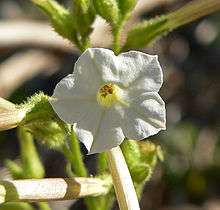Nicotiana attenuata
| Coyote tobacco | |
|---|---|
 | |
| Scientific classification | |
| Kingdom: | Plantae |
| (unranked): | Angiosperms |
| (unranked): | Eudicots |
| (unranked): | Asterids |
| Order: | Solanales |
| Family: | Solanaceae |
| Genus: | Nicotiana |
| Species: | N. attenuata |
| Binomial name | |
| Nicotiana attenuata Torr. ex S.Watson | |
Nicotiana attenuata is a species of wild tobacco known by the common name coyote tobacco. It is native to western North America from British Columbia to Texas and northern Mexico, where it grows in many types of habitat. It is a glandular and sparsely hairy annual herb exceeding a meter in maximum height. The leaf blades may be 10 centimeters long, the lower ones oval and the upper narrower in shape, and are borne on petioles. The inflorescence bears several flowers with pinkish or greenish white tubular throats 2 to 3 centimeters long, their bases enclosed in pointed sepals. The flower face has five mostly white lobes. The fruit is a capsule about a centimeter long.
When this tobacco is eaten by the larvae of the tobacco hornworm (Manduca sexta) the plant emits green leaf volatiles that attract Geocoris bugs, which are predators of the worm.[1]
Uses
This plant was used for a great variety of medicinal purposes by many Native American groups, and was smoked ceremonially by the Hopi, Apache, Navajo, Paiute, and other groups.[2]
Among the Zuni people, the smoke is blown over the body to reduce the throbbing from rattlesnake bite.[3] It is also smoked ceremonially among them. [4]
- Nicotiana attenuata plant grown at a field site in Utah
 Manduca feeding on Nicotiana attenuata
Manduca feeding on Nicotiana attenuata Coyote tobacco forming fruit capsules
Coyote tobacco forming fruit capsules
References
- ↑ Bhanoo, S. From a Desert Plant, a Scented Cry for Help. New York Times August 30, 2010.
- ↑ Ethnobotany
- ↑ Stevenson, Matilda Coxe 1915 Ethnobotany of the Zuni Indians. SI-BAE Annual Report #30 (p. 54)
- ↑ Stevenson, p.95
External links
| Wikimedia Commons has media related to Nicotiana attenuata. |
- Jepson Manual Treatment
- USDA Plants Profile
- Calflora Database: Nicotiana attenuata (coyote tobacco)
- GRIN Species Profile
- Photo gallery